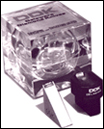Maximizing the physical properties of diamond through exceptional craftsmanship, sophisticated equipment and customized engineering, DDK’s longer-lasting, diverse line of knives feature precise edges and an unconditional guarantee.
BLADE ANGLE GUIDE
 Choosing the Proper Angle for your Sectioning Needs
Choosing the Proper Angle for your Sectioning Needs
Diamond knives with included angles other than 45° have been available since the 60’s when DuPont made 55° knives for zeolite catalyst sectioning. Low angle knives, with included angles of 35°, were introduced in 1990 as a result of work showing some reduction in compression when cutting extremely thin sections of soft material. Today, references showing successful sectioning of a wide range of materials with a wide range of included angles can be found.
Be aware, however, that durability is a function of included angle. The small facets you see on the edge of any knife, diamond or not, are there strictly to increase its included angle and durability. With diamond knives, unavoidable minute damage due to instability, vibration and accident does occur. The accumulation of this damage (as well as catastrophic damage) eventually makes resharpening necessary. All things being equal, higher angle knives are more resistant to this damage.
Let empirical data be your guide in selecting included angle. For biological samples, unless you are doing EELS with the Zeiss EM902 where 30nm thick sections are needed or morphological studies where dimensional changes on the order of 5% are important, the 45° knife will continue to be the standard. For materials samples, refer to the literature or custom testing services such as ours for guidance. We would be happy to share any results you contribute at this site.
Learn about the Unique Properties of Our Knives
Knife Care and Use (PDF)
Knife Selection (PDF)
